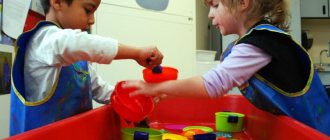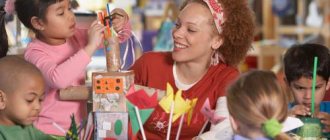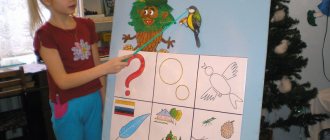Objectives of teaching design in the middle group of kindergarten
Objectives of teaching design.
Middle group
Educational objectives:
Structural and technical:
Construction material:
- learn how to independently transform buildings in length, width, height
-learn to build buildings in accordance with the size of toys, using parts of different colors
- learn how to build according to the named topic, according to the conditions, according to the plan (plan the sequence, select parts according to shape, size, stability)
- to consolidate technical construction skills (the ability to place bricks on edge, at corners, closing the space)
Paper:
-teach paper construction: bend a rectangular sheet of paper in half, aligning the sides and corners, iron the fold
-glue parts to the main form (windows, doors, wheels)
Natural and waste material:
-involve children in making crafts from natural and waste materials
-create constructive images by transforming various workpieces
-use glue, plasticine, tape, matches to hold parts together
Developmental tasks:
Construction material:
-reinforce familiar names of parts (cube, brick, plate, prism) + introduce new ones
— learn to use them taking into account the basic design properties (size, stability, shape)
- learn to analyze a building sample: identify the main parts and distinguish them by size and shape, establish the spatial arrangement of these parts relative to each other (in houses: walls, ceiling at the top; in a car: engine, cabin, body)
— continue to develop a sense of form when creating buildings and crafts;
- continue to develop visual-effective and visual-figurative thinking, imagination, attention, memory;
Paper:
-learn to identify and name a sheet of blank paper by shape (square, circle, rectangle), size, color
-develop creativity and artistic taste in the design of paper crafts
Natural and waste material:
-introduce children to a variety of natural and waste materials and their properties
-develop independence, the ability to find a way to make a toy
- expand the child’s vocabulary with special concepts: “proportion”, “scale”, “texture”, “plasticity”, “proportion”.
Educational tasks:
— continue to cultivate interest in design and constructive creativity;
— cultivate the ability to follow the teacher’s verbal instructions during the exercises;
- aesthetic attitude towards works of architecture, design, products of one’s own constructive activities and the crafts of others;
- accuracy when working with various materials and tools
- ability to work in an organized manner, together with children and the teacher in the process of creating common work
Construction
Development of constructive abilities in children of middle preschool age in design classes and in joint activities
In the fifth year of life, the child’s leading activity remains object-based and play activity begins to develop.
The peculiarity of constructive activity is that it, like a game, meets the interests and needs of the child.
Children's design is the process of constructing such buildings, which provide for the relative spatial arrangement of parts and elements and methods for connecting them in accordance with the purpose of the buildings. In the design process, children learn to assemble a whole from individual parts, which requires active thought and imagination. Identifying the characteristics of objects, comparing and generalizing occurs in a visually effective way.
Construction is of great importance for the development of a child. In design classes, children learn to plan upcoming work, analyze their actions, draw conclusions, and correct mistakes.
Construction brings children together and engages them in collective activities. At the same time, children show resourcefulness, invention, consult, agree on who will do what, and help each other. Design classes develop creativity, dexterity, cultivate perseverance, hard work, and patience.
Construction makes it possible to work with geometric bodies, in practice to get acquainted with the sensory characteristics of objects (color, shape, size) and learn to operate with them, to learn the correct names of the parts of a building set, to improve the perception of spatial relationships (to the right, to the left, above, below, behind, next to , before) . Actions with large building materials help strengthen the child’s muscles; Playing with tabletop building materials develops fine motor skills. Constructive activities develop the eye and train hand-eye coordination.
The relevance of the identified problem determined the choice of the topic for self-education “Development of constructive abilities in children of primary preschool age.”
Having studied the psychological, pedagogical and methodological literature (L. V. Kutsakova “Design and artistic work in kindergarten”), the following goals and objectives were set.
- Goal: To develop the constructive abilities of children of primary preschool age in design classes and in joint play activities.
Tasks:
- Learn to build elementary buildings: paths (narrow, wide, long, short), turrets (two, three, four cubes placed one on top of the other), ladders (with two or three steps), furniture (chair, sofa, crib, table), car, slide, house, gate, etc.
- Continue to introduce the child to different parts (of different sizes, shapes, colors, made from different materials), to help memorize the names of parts of building materials (cube, brick, plate, prism).
- Enrich the child’s practical experience regarding the arrangement of parts on a plane and in space (put one brick on top of another; it can be a support for a plate; a brick can be placed on the long narrow side and the short narrow side - a fence)
- Practice planar design (overlay cut out figures on the ones shown, put them in the slots, lay out images according to the teacher’s model)
Before starting constructive activities with children, various methodological recommendations for organizing and conducting educational classes and joint activities of children were studied.
At the initial stage of work, children were examined and the results were recorded in diagnostic cards. (see Appendix No. 1) Having studied the abilities and interests of the pupils, it turned out that not all children can distinguish building material by shape,
don't know the names of the parts,
They don’t know how to build basic buildings.
- To develop constructive abilities, a subject-based developmental environment in the group was created, which is one of the conditions for the development of creative activity of preschoolers. They entered it
- Soft modules
- Freibel materials
- Bright colorful didactic material, small tabletop and large floor building material, as well as construction sets
- Methodological support.
They are age-appropriate for children, safe and made from environmentally friendly materials.
For convenience, building materials and construction sets are arranged in boxes of different sizes; A catalog of entertaining games and construction exercises has been developed.
Using the results of the survey, I drew up long-term planning for the sections of the “Krokha” program. When planning design classes, I took into account the age of the children and their level of development. In classes, children acquire new knowledge and skills. I conduct classes systematically with the entire group of children once a week. There is a certain algorithm for conducting systematic classes.
Lesson algorithm:
1. Problem (motivation for activity)
2. Acquaintance with a new material (details of building materials)
3. I invite the children to name familiar parts of the building material
4. Show a sample (if the construction is complex, show it in stages)
5. Independent implementation by children (assistance)
6. Identification with a sample
7. Playing off the building (summarizing based on the result)
In addition to systematic classes according to the program, I conduct a lesson once a month - consolidation, this lesson consists of game tasks that are aimed at consolidating the acquired knowledge and skills in children and acquiring new ones based on them. For example: Topic “Fences” game tasks for this topic (see appendix)
Such game tasks are carried out on all topics of long-term planning.
An essential factor in the planning and methodology of conducting design classes is the relationship between learning in the classroom. Integration by merging program material
Design and familiarization with art. literature, speech development, experimental activities, familiarization with the environment.
Example: Fiction and Construction:
We get acquainted with L. Tolstoy’s fairy tale “The Three Bears”, after reading I ask the children: “What can you build for the bears?” What was Masha sitting on? (chair) “What did you sleep on? (bed). We read the fairy tale, remembered the elementary buildings (chair, bed, house), select the necessary building parts and begin construction.
In his free time, the child is busy playing, which, under the guidance of the teacher, smoothly turns into a role-playing game. While playing, I continue to teach children how to design. But I do this unobtrusively - so that the children do not feel that they are being taught (“Hello cat!” I turn to the toy for which the child built a house. _ Who built you such a house? Do you like living in it? Etc. )
Game “Let's build a house for a bear and a bunny (see appendix)
Children are very interested in integrated activities, which I often use when learning a new topic or consolidating.
Also, while cleaning up building materials, I continue to teach children to compare parts by color, shape, size, carefully disassemble buildings and sort parts.
The connection between construction and experimental activities can be seen during a walk in the sandbox. We study the properties of sand (loose, sticky, dry, wet). We learn to make simple buildings from sand (I show and explain how to fill a mold, compact the sand, tip it over, how to lift it so as not to damage the Easter cake). Raking sand from both sides with our hands and compacting it, we build a fence.
For joint activities with children, I have developed a card index “Entertaining games and design exercises” (see appendix). Joint activities are carried out in the form of didactic games, entertaining exercises both in subgroups and individually in the morning and evening hours.
Design can be divided into two types
- Volumetric
Initially, three-dimensional design is used, since a child at an early age needs to not only see what he will build buildings from, but also be sure to touch the parts he will use.
- Planar (hereinafter applique).
A more complex type of design,
requires visual skill
knowledge of shape and size
differences in geometric shapes
1. Volumetric construction – games with building materials:
- “Build a house for a bear and a bunny”
-“Let’s build a tower for the princess”
- “Ladder for a squirrel”
- “Find the same detail”
- “Build according to the model”, etc.
When playing with building materials, the child takes into account the shape of the object, continues to get acquainted with the basic forms, learns to distinguish and name some.
2. Planar design - these are games that train children in superimposing cut-out figures on the ones shown, laying out the image according to the model. For each such exercise there is an appendix in the form of cards, plot pictures, contour diagrams. (See appendix) By completing such tasks, children easily remember and distinguish geometric shapes. When learning planar construction, a child learns to see a cube in a square, a prism in a triangle, a ball in a circle, the development of sensory standards. Planar design has a plot, which means a certain experience about the object environment. Conducted in subgroups in joint activities. The development of this type of design will help in the future when working with applications.
If I notice that a child has weak design abilities, and therefore interest in an activity is weakening, then I try to interest him. More often I build with him, look at the illustrations, and connect him with children whose construction is going well. When giving tasks of the same type, I always differentiate them taking into account their complexity. For example, everyone lays out everything in the office, but some can be given more details to lay out, others less, etc. Knowing that from the subgroup only one or two children will cope with the task, I still give this task as a collective one. Moreover, when evaluating, I always emphasize the common efforts of the guys and helping each other. This technique especially stimulates mutual learning.
One of the areas of activity is working with parents:
- Parent meeting “Young Builders” - May 2009
- Consultation “Types of design and their significance in the life of a younger preschooler” - March 2010.
- Stand for parents “Design Techniques”
After the first year of using systematic classes in the sections of the “Krokha” program, and using entertaining games with building materials in joint activities, the following results were noticeable: (for diagnostics, see Appendix No. 2)
Continuing work next year on this topic, I used not only systematic classes according to the program. I continued to introduce the children to building materials – volumetric construction, with the help of entertaining games and exercises that I developed. She introduced the children to planar construction, which made it possible to work with geometric bodies, master the sensory characteristics of objects (color, shape, size), and learn the correct names of geometric figures.
Summarizing the use of systematic classes, integrated classes, game tasks and entertaining games and construction exercises, the children and I achieved the following results: (for diagnostics, see Appendix No. 3)
Results of work
- Mastered the simplest design techniques (narrow and wide paths, towers of various sizes, furniture, vehicles, houses, gates)
- Parts are distinguished by size, shape, color.
- Name the parts of the building material (cube, brick, plate)
- Place the cut out figures on the depicted ones and lay out the image according to the sample.
Prospects
- Getting to know natural and waste materials.
- Working with paper (origami).
- Creation of an artistic design circle.




